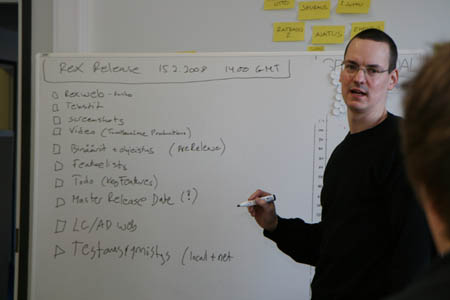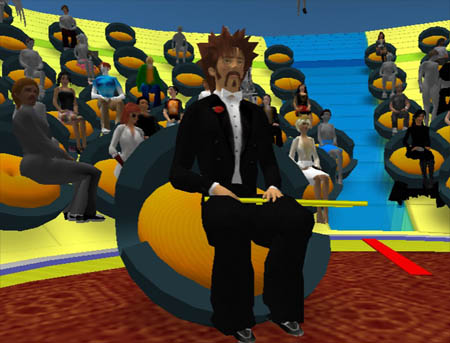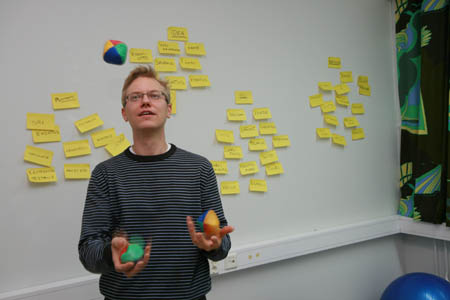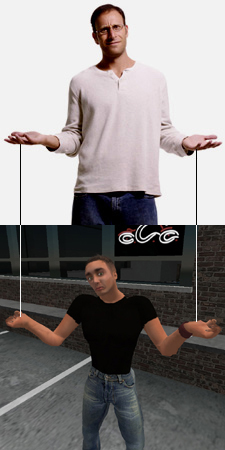Tony Manninen, the CEO of LudoCraft games studio (the client side development division of realXtend) who has being doing all this amazing recent development on OpenSim, has a vision for Avatar 2.0 that he is bringing to OpenSim. The possibilities for the future integration of realXtend features (that include meshes and the ability to import proper 3D models) with Second Life is currently under discussion – more on this soon.
We have tried to keep the rexviewer as compatible as possible. We totally appreciate what Linden Lab has done and we are trying to do our best to co-exist with their beautiful social innovation.
When I interviewed Tony (see interview later in this post), I was very excited not only by the scope of his vision and his devotion to enhancing the user experience and possibilities of virtual worlds, but also by his absolute determination to manifest this vision in code with the the utmost speed
The next release of realXtend server and client will be published on 29th of February, 2008 at 4pm (Helsinki time). The features that will be in this release and a roadmap for the future are here.
Virtual Worlds that make our “real” and “virtual” lives better
What do I mean by an exciting vision for virtual worlds? There are many visions for virtual worlds floating around and some of them are not so appealing to me, like the notion of a virtual world as a walled garden/company town put forward by the CEO of There.com, Michael Wilson.
When Michael Wilson was interviewed in Second Life by Beyers Sellers (Robert Bloomfield, Cornell University) for Metanomics this week, he gave the impression that creating a controlled environment for marketing is the number one priority of There.com.
In my view, which seemed to be shared by many of the Second Life audience participating in the group chat, this notion of designing virtual worlds as “big brother houses” is the epitomy of “the metaverse gone wrong.” You can see the full interview here on SLCN. Also see here for Christian Scholz’s (Tao Takashi in Second Life) excellent summary and analysis of a virtual world according to There.
I hope there are some more positive aspects to There.com than this interview conveyed.
Despite ups and downs and growing pains, Philip Rosedale’s vision for Second Life has always, in my view, had at its heart the motivation to make people’s “real” and “virtual” lives better. See The Making of Second Life by Wagner James Au for a fascinating look at the early days.
While Linden Lab is still working hard to break free of the “walled garden” model, with OpenSim and realXtend, the expansive vision that they have pioneered has been open sourced even before they have finished their own open sourcing project. And now, an open source development community of genius and depth (including Linden Lab) is rising to the challenge of taking this vision of making our “real” and “virtual” lives better to the next step.
There are several Open Source virtual world platforms available now, including Ogoglio, Croquet and Sun’s Wonderland. In the news today is the Open Virtual Worlds Project from The New Media Consortium (NMC) and Sun Microsystems which as VWN points out is similar to efforts announced by the Immersive Education Initiative to create an Education Grid across Second Life, Wonderland, and Croquet.
But OpenSim stands out from the pack because it inherits from Second Life an awesome set of tools to facilitate user generated content. This emphasis on user generated content is, of course, key to how Second Life has become the largest and most highly developed 3D immersive world to date. The fact that OpenSim is a platform built for people to build in was of one of the reasons that realXtend chose to work with OpenSim after they investigated all the available open source options. Also important, Tony noted, was the depth of the development community in OpenSim and Second Life.
Philip Rosedale speaking in Second Life at the MacArthur Foundation event on The Future of Philanthropy in Virtual Worlds
The Future of Ubiquitous Game Design
There are many inspiring alternative visions for virtual worlds emanating from Game Developers Conference 2008 which have been percolating through the blogosphere. Particularly interesting, to me, are the new possibilities for avatar expressiveness and some interesting ideas on the future of ubiquitous game design.
I was thrilled to discover that Tony Manninen has been doing research on avatar expressiveness since 2000 (see his papers here). Rich Interaction in networked virtual environments, avatar expressiveness, and the future of ubiquitous game design are his forte. How very cool!
Tony’s vision is to take social gaming to the next level and to produce games that are so heavily collaborative that they reach deep into our experience of the pleasures doing things together, our enthusiasm for team sports, and childhood memories of the enjoyment of playing together. He has been exploring these ideas of team play and community in earlier LudoCraft games like AirBuccaneers.
Ray Kerzweil’s keynote GDC 2008 laid it on the line: “Games are the harbinger of everything.”
But some of my favorite GDC 2008 quotes are from Jane McGonigal (see her blog post “Reality is Broken” – My GDC Rant) and in Liz Lawley’s copious notes on “Pouring Fuel on the Fire: Game Designers’ Rant.”
Jane McGonigal: I’m not mad at game designers. Compared to the rest of the world, we have it all figured out. Our medium kicks all other media’s ass. We make more people happy than any other platform or content in the world. (If you don’t believe that, you’re not paying attention to what’s happening.) We’ve won. Games have won. As an industry we’ve spent the last 30 years learning how to optimize experience. Brains, bodies (recently), and hearts are all engaged. That’s the good news.
The bad news is we rule the virtual world only. Reality is broken, and we’re not fixing it, we’re offering alternatives to it. We offer better experiences, better socialization, in virtual experiences. That needs to start changing. If reality is broken, why aren’t game designers trying to fix it? It’s our responsibility to design systems that make us happy and successful and powerful in real life? We have the power and the responsibility.
Jane shows an image of her favorite “I’m not good at life.” graffiti (from Liz Lawley’s notes).
Tony Manninen is an innovator committed to bringing the power of games into arenas we are yet to dream of.
Jane McGonigal has some nice examples to stretch your mind in this direction. For example, the Sniflabs collar remembers other dogs you’ve encountered. “We can play games with our dogs. What if I could play an MMO with my dog?”
Why will it make our “real” and “virtual” lives better to take play into every nook and cranny of our experience? Because, as Kurzweil points out, “Play is how we principally learn and principally create.” Jane McGonigal goes further:
I have spent the last year doing research on happiness. Instead of trying to figure out what’s broken, these people are trying to figure out what makes us happy. Every positive psychologist has found the same thing. Happiness is 1) having satisfying work to do, 2) the experience of being good at something, 3) time spent with people we like, and 4) a chance to be part of something bigger than ourselves.
“If you are a game designer you are in the happiness business.”
Jani Pirkola, realXtend project manager, works on innovation in the offices of LudoCraft.
LudoCraft = The Art of Designing Games and Play
Ludo – Theories of game and play
Craft – Art of game design and development
Reinventing the technologies of expression and experience.
At the Metaverse Roadmap meetup, Mitch Kapor pointed out “3D cameras would make virtual worlds easier to use.” And Bob Moore (on left above, me on right) asks in this excellent post, Is “free gesticulation” for avatars here yet?
When I asked Tony this question he replied:
“Our avatar will have enough “bones” for full facial expressions, etc. When the actual base architecture of the avatar is fully functional, there’s a possibility to use webcam, voice, or other input devices to control your avatars facial expressions. It can be true 1:1 mapping, but of course it can be something else as well. You can be yourself, or, you can change your “output” to something else.”
Tony, through realXtend, is reinventing the technologies of expression and experience.
Man Upside Down from The Book Of Urizen, William Blake
Interview with Tony Manninen, LudoCraft
Me: Second Life as a platform has been pretty much ignored for game development up to this point. Do you imagine transforming OpenSim and Second Life into platforms suitable for MMOG?
Tony: I am running the company and also making sure the realXtend development reaches the required quality and performance standards you would expect from MMOGs.
We’d definitely love to make games for Second Life, but at the moment the end-user experience is not exactly what you would expect from a game system. Therefore, we’ll pay heavy attention to things like responsivity, graphics quality, frame rate, etc. If we manage to keep up the momentum of realXtend development, then I’m sure there will be some interesting games spawning up in the near future…
Developing a sophisticated game engine is not an easy – or cheap – task, so there’s a loads of challenges ahead. But I truly believe that is the only way forward. With game-like interfaces and features you’ll be able to get much more heightened experiences.
Me: Have you worked out anything with LL yet re keeping the realXtend viewer compatible with SL?
Tony: We have tried to keep the rexviewer as compatible as possible. We totally appreciate what Linden Lab has done and we are trying to do our best to co-exist with their beautiful social innovation.
Me: But will you be able to work out a licensing deal under the GPL so that they can integrate your code into their browser?
Tony: The whole licensing scheme is still undergoing some serious thinking processes. We will try to find the best possible option in order to satisfy the needs of hungry virtual world adopters. GPL has its challenges. But, on the other hand, everything invented by a man can be re-invented by another. I am sure there will be a fruitful solution to the licensing issue. At the moment we are concentrating on releasing all the code to the general public, so that all the enthusiastic developers out there can join the forces and increase the momentum.
I’m pretty sure the pieces will eventually find their right places. I am really happy about the response we’ve got from Linden Labs – it’s great to think we might be able to give something back for them.
Me: Is it safe to say the licensing issues are on the table and being worked out?
Tony: There’s definitely some serious working-out being done, so I suppose it is safe to say that.
Me: I know Will Wright creator of Sims online and Spore has spoken a lot on the spiraling costs of content production and that diminishing returns for content development at these high costs. He has gone to procedural programming with Spore to take gaming on another path. But, it seems to me that you are taking another approach by trying to bring SL up to gaming standards – is this correct, or are you doing something different?
Tony: I guess that’s quite correct assumption – at least in relation to LudoCraft. This is not necessarily a conscious decision. It’s more like the costs of licensing a decent game engine are generally so high that they more often than not fall out of reach of start-up companies and small developers – let alone universities, communities, etc.
We have tried to find a suitable platform for our collaborative games, but since there were no perfect solutions, we decided to try and make one. Not alone, but by joining forces with our partner company Admino and several other keen developers.
The OpenSim merger will increase the development base even further, so there’s a great chance we’ll actually pull this off.
Like I said, there’s loads of challenges, huge amount of work and some design issues involved. But the Open Source communities have proven themselves earlier, so why not now.
Me: What do you think are the chief design issues to be addressed?
The realXtend project includes LudoCraft and Admino, plus we have several sub-contracting developers doing work with us.
The main issue is the divide between social 3D worlds (like SL for example) and MMOG. The gamers tend to avoid these social virtual worlds for obvious reasons [the quality of the experience from a gaming POV]. However, if we manage to develop a platform that can serve both purposes, then I’m sure things will change.
The main design issues, therefore, are the performance, audiovisual quality, rendering, frame rate stability, responsivity, interaction, etc.
Numerous issues that are not necessarily critical in purely social virtual world, but are absolutely essential in any multiplayer game environment.
Plus, if well taken care of, these issues will boost the whole end user experience in the non-gaming situations as well.
Me: You have gone a long way with the rendering and meshes what will be the next most important features and when do they arrive?
Tony: Inverse Kinematics and procedural animation are essential features if we want to have truly expressive and adaptive animations. We see avatars as main tools for self-expression. We’ve researched the issues since 2000 and we believe we are on the right track. With flexible and powerful expression potential and accurate controllability, the users will be able to communicate with their avatars so much more than is possible nowadays. The concept of Rich Interaction is something we will utilize here and it will be interesting to see the results when the system is actually usable by the general public.
Vehicles and projectiles are really important so they sit heavily on our roadmap.
Me: Are you going to do 3D face mapping etc – I know that this is getting close to doable now?
Tony: Oh, the required list of features is endless. There are several key features in terms of game development, but also some interesting stuff for more serious applications.
Our avatar will have enough “bones” for full facial expressions, etc. When the actual base architecture of the avatar is fully functional, there’s a possibility to use webcam, voice, or other input devices to control your avatars facial expressions. It can be true 1:1 mapping, but of course it can be something else as well. You can be yourself, or, you can change your “output” to something else.
Me: OpenSim is very attractive for a number of vertical applications – building automation is one you mention. How focused are you on getting the OpenSIm platform ready for the huge mirror world, 3d info machine/command center market?
Tony: In terms of the mirror world, we already have some interesting pilot projects that target those features. It may be less juicy than making cool games, but it provides some highly interesting scenarios.
Me: What are your pilot projects?
Tony: I don’t think I should go into details at the moment. We will include a list of initial projects and collaborations for our next announcement, which is due 3rd of March (latest). We want the third parties to have their saying first before making these public.
Me: The realXtend avatar server is a new way of connecting sims – could you tell be more about your vision there?
Tony: The main vision is: there should be only one. Only one avatar, one user account, one login, etc.
It is ridiculous that I need to have an avatar in SL, character in WOW, nickname in IRC, and whatnot. I mean, it’s ok if I want all these different identities, but what if I would be, eh, me in all these worlds, perhaps doing business, shopping, hobbying, and so on. There should be an option for me to jump from world to world without the hassle of logging in and logging out
Me: And how will the work you have done on the avatar server alleviate this problem unless SL, WoW and other cooperate on interoperability?
Tony: Think of it more like the 3d web. realXtend/OpenSim is like the Apache of virtual worlds, rexViewer is the Mozilla or Firefox of whatever. When “surfing” the web, you are not constantly required to prove and change your identity when loading different pages.
Me: But because there is no equivalent of http for virtual worlds yet, how will this work re the other worlds?
Tony: Ah, that’s the critical question: it won’t. There is some interoperability work going on in terms of creating the standards. The problem is, this work tends to be slow. We are not willing to wait that long. We want to see some action. That’s why we thought that we’ll start the wheel rolling and then see what happens.
Me: So at least now OpenSim worlds and hopefully Second Life will be able to connect this way?
Tony: The openess is the key to the lack of unified protocols. When the interfaces and APIs are open and transparent, people are free to develop applications, converters and bridges between different systems.
Right, at least OpenSim is now reachable, plus we want to get the teleport between SL and OpenSim/realXtend up and running, at least in the quick-and-dirty way so that people will have a chance to experience the feeling of world-to-world hopping.
Me: So in terms of this experience of avatars hopping between OpenSim worlds how do you think this will change the need /or not for large grids like SL or any of the new ones like OpenLife that are springing up?
Tony: I think there’s still need for various technical solutions like there is need for lighter and heavier websites. There are different applications, different scenarios and different user requirements. It is still really enjoyable feeling to be able to actually walk – ok, virtually at least, from one server to another. With hopping there may be some loading involved (like when surfing the web). So I guess the big grids won’t go anywhere. We’ll just have more modalities in terms of servers/worlds.
Me:So what are your expectations for concurrencies on OpenSim in the near future?
Tony: Hmmm… I’m not sure yet. OpenSim is an excellent initiative and there’s already a substantial user base. There are a lot of work to be done in terms of integrating realXtend codebase to the OpenSim, but since the visions and missions of the people involved are aligned, the hard work is a minor detail in the process.







February 27th, 2008 at 10:30 pm
Another great post. I think we all hope that future sims really are going to make, as you said – “people’s ‘real’ and ‘virtual’ lives better” and not only controlled environments for marketing.
March 2nd, 2008 at 8:24 pm
Good lord, does anybody else find Jane’s comment as arrogant and stupid as some of us are finding it?! Stick with games, girl, and leave the broken reality driving to representative democracy, thank you very much.
>he gave the impression that creating a controlled environment for marketing is the number one priority of There.com.
I don’t have a problem with that. In fact, every single virtual world supplier needs to think of that. It’s just that they need to have different niche markets. Perhaps your favourite Bozos in Paradise sort of comfort level for advertising is an advert that tells you about a new i-Phone widget, or tells you about an interesting conference coming up, or whatever. You associate advertising with something grubby like toothpaste or jeans, but you want it if you can dress it up and take it out as “news I can use in my metaversal career”. So it just means a different marketer for a different audience.
It’s also the case that the future of the metaverse, whether we like it or not, lies with those who can fund their technological development through mass culture that the masses can easily access, and that means you will turn up your nose at it, but they will win. That’s why Mattel or MTV are the keynote speakers at a big VW industry conference with people with budgets of millions to spend and not, oh, you or me. The metaverse is not going to be about free-trade organic coffee, Ugo.
I also think it’s completely and utterly premature to say OpenSim has somehow opensourced SL and now it’s free and productive and going on its merry way. It isn’t at all finished and doesn’t at all have any assurance of creating the kind of customer list and internal coherent economy that Second Life has.
What good is it to extend the ability of avatars to walk between worlds if they are merely going to be visiting a lot of empty Mars space stations and tag sales with resold copied content from other worlds?
April 7th, 2008 at 6:23 am
Now that I’ve learned that OpenSim isn’t even going to put in any currency or permissions systems, I have to question this idea of freedom in this non-walled garden even further!